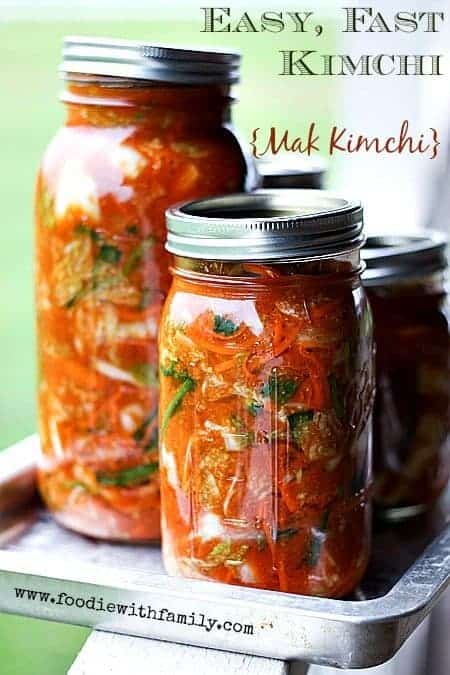
Love this Easy, Fast Mak Kimchi recipe? Check out our other fabulous Korean Food Recipes!
If you’ve been with me for a while, you’re well aware of my undying love for kimchi. Yes, it is stinky and bubbly and more than a little wild, but WOWZA the taste and the texture are so worth it.
If you’re new to the Foodie with Family family and you aren’t familiar with kimchi, I can give you a super condensed description; it’s essentially spicy, aromatic Korean sauerkraut. Today, I’m bringing you a fool-proof Easy Fast Kimchi recipe {Mak Kimchi}.
What is Kimchi?
Kimchi comes in almost as many forms as there are vegetables because nearly any vegetable can be fermented. They range from super mild smell to mega funky and mellow to melt-your-face-off spicy and there is one for every possible point in between.
The kimchi recipe that I’m sharing today is my family’s favourite version. It’s chock full of fabulous pro-biotics (as most kimchi is) and the longer it ages (translation: ferments) the stronger it becomes in both flavour AND pro-biotic content.
It’s like yogurt on steroids, people. That’s how good it is for you!
Is Kimchi Good For You?
Health Magazine named kimchi one of it’s Top 5 World’s Healthiest Foods. It is is low in calories and fat and high in dietary fiber and wicked high in Vitamins A, B, and C.
Many (if not most) Koreans eat a little kimchi with each meal or at least once a day. Kimchi is credited with helping most Koreans avoid obesity by virtue of its ability to satisfy even while being low calorie and low fat.
Seoul National University conducted a study and claimed that chickens infected with the H5N1 virus, also called avian flu, recovered after eating food containing the same cultured bacteria found in kimchi. That’s good enough for me!
How to Make Kimchi
Let’s get cracking and make some kimchi, shall we? The variety we’re making today is an Easy, Fast Kimchi recipe or Mak Kimchi…
In other words, it’s already cut up and ready to shovel into your mouth. Unlike what is usually just called ‘kimchi’ which is whole heads of napa cabbage smeared with the kimchi paste and allowed to ferment all wrapped up.
This version is FAR easier to make and far faster to be ready. Bonus, it is way easier to eat straight from the jar with a pair of chopsticks or a fork.
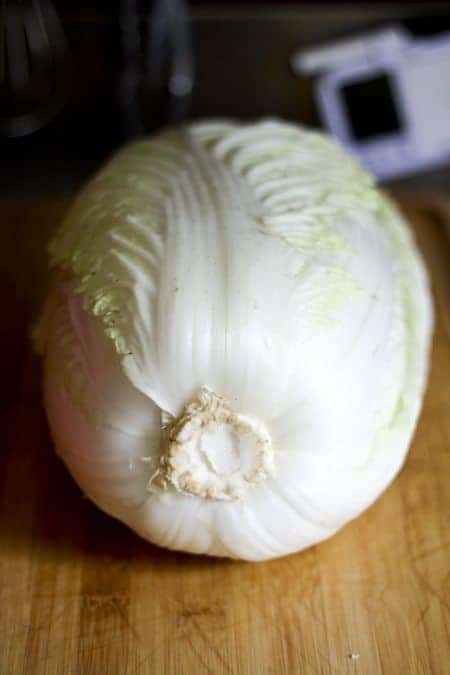
Do I need special tools to make kimchi?
In short, no. All you really need is a knife, a cutting board, and a big bowl. You will need a couple of ingredients that you may not have purchased before, but never fear, they’re not hard to find these days and I’ve included links to them below.
To begin with, you’ll need a big old head or two of Napa cabbage. I had two heads like the one above weighing in at about 3 pounds each.
It yielded, when all was said and done, about 3 quarts of kimchi, so that was perfect for me. You can cut that back if you think you can’t consume that amount of our Easy, Fast Kimchi recipe or Mak kimchi.
But I find all sorts of places to tuck it in, so it’s not an issue here and it’s only my husband, myself, and two of our boys who eat it. We love our kimchi.
Kimchi Recipe
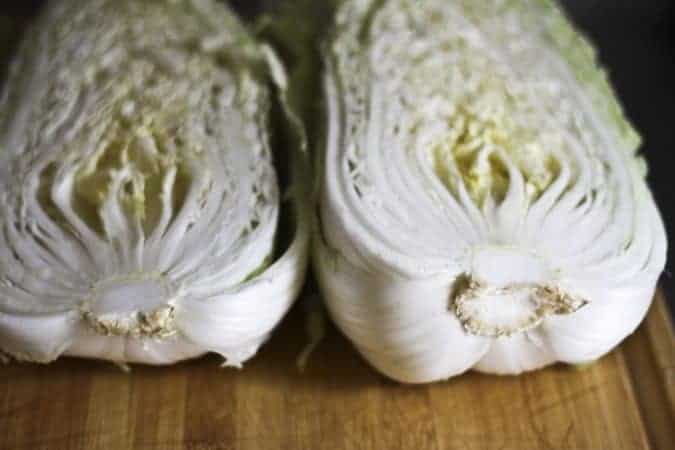
Lob your cabbages in half lengthwise. Use a paring knife to remove the gnarly core from them before cutting in half lengthwise again, leaving you with quarters.
Cut across the quarters to make bite-sized squares of cabbage. I usually shoot for 2-inch squares.
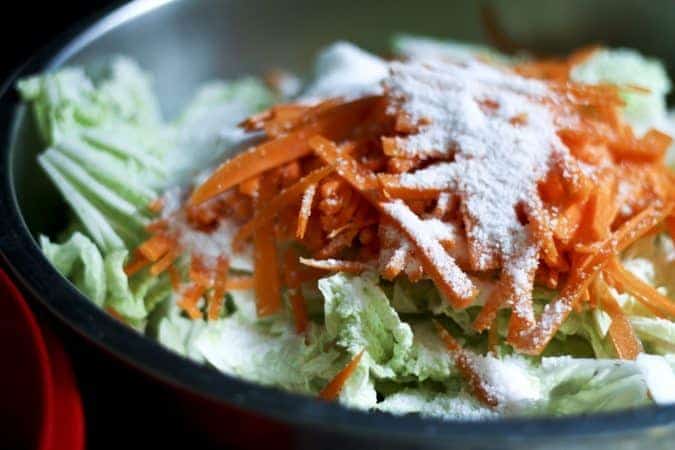
Add the cabbage to a monstrously huge bowl (or bowls), top with the julienned carrots, and sprinkle salt over the whole works. Toss the veggies and massage the mixture until the cabbage just starts to wilt.
Pour in enough cold water to over all the cabbage and carrots by a bit. It doesn’t have to be swimming in water, just covered.
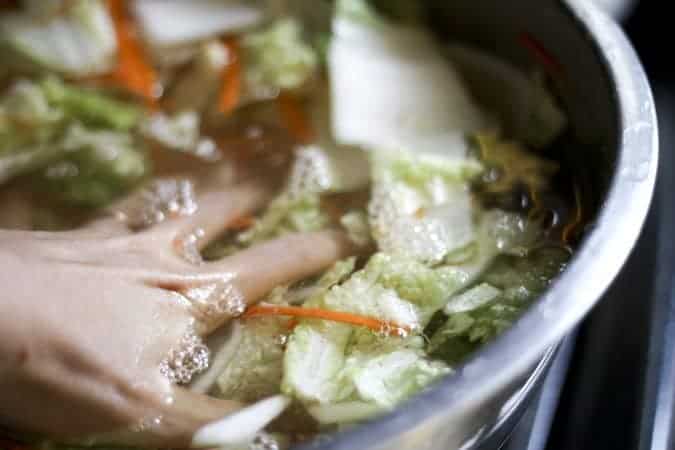
Stir it up with your hands and let it rest at room temp for a couple of hours.
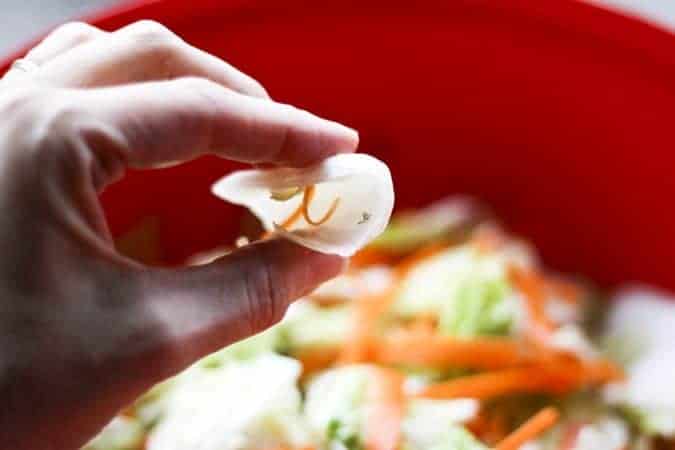
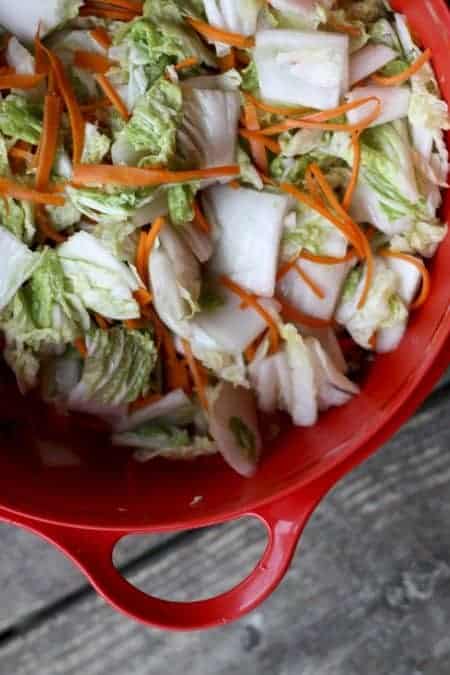
After a couple of hours, when the sturdier pieces of cabbage have become flexible, pour the whole lot into a strainer and let the brine water drain away.
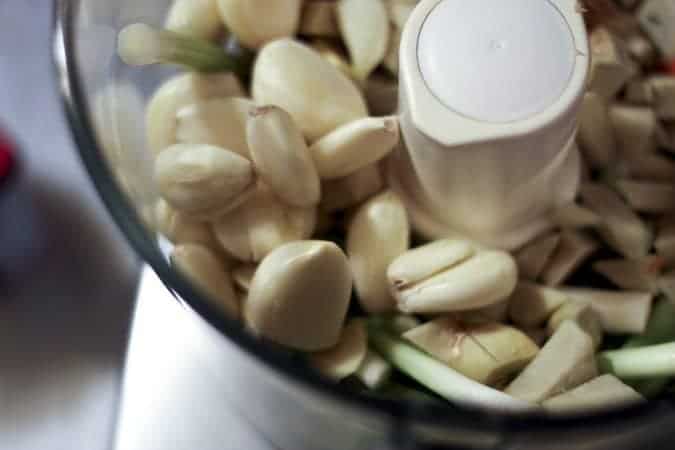
Now you’re going to whizz up the good stuff. Garlic, ginger, the white parts of scallions, Korean Red Pepper Powder*, fish sauce, unsweetened pear or apple juice, miso paste, and whatnot go into the food processor or blender.
Obliterate and smash it all into a lovely, red, fabulous smelling paste. It’s worth noting that you shouldn’t just up and increase the garlic because it can make kimchi linger more on your breath than you’d like it to do.
It also tastes out of balance if you add a lot more. Be aware.
And by the same token, you shouldn’t increase the ginger willy-nilly because that can make the final product a little more bitter than you’d like it to be. Start with the mixture and proportions I’m giving you and then play with it in subsequent batches.
*It’s important to note that you cannot use American or Mexican Chili Powder in place of the Korean pepper powder here. They’re COMPLETELY different animals. It may end up tasty, but I haven’t tested it so I cannot speak to it.
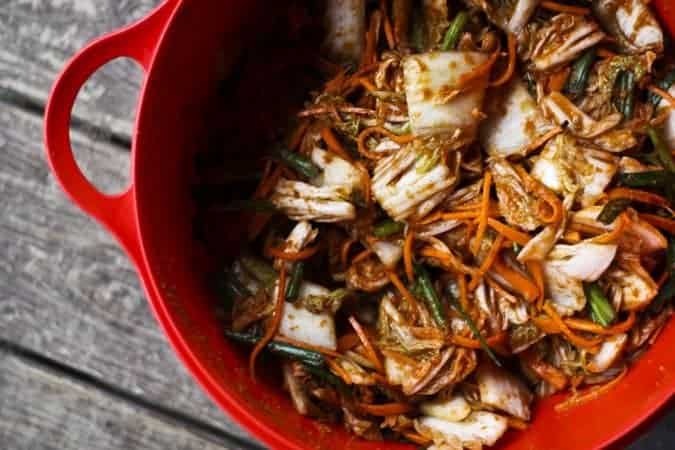
Now you’ll CRAM this stuff into jars or food-safe plastic containers. When I say cram it, I mean shove it in there as firmly as you can without putting your fist through the bottom of the jar.
I do prefer glass canning jars, if you’re wondering, because they don’t retain odors like plastic does, and, well, this stuff is odiferous! You can use a dedicated plastic kimchi bucket if you’d prefer, though.
Gently place a lid and ring on the jar, but don’t screw it tightly into place because BOOM. It’ll pop. This is active stuff, mes amies!
Place the jar on a rimmed pan or baking dish. The rim is pretty crucial here, because as the kimchi ferments at room temperature (and more slowly but still actively in the refrigerator) it will bubble up and may release a little juice over the edge of the jars.
In other words, you could have a kimchi river a-flowin’ on your counter top unless you take precautions. It’s easiest to use the pan and not worry about your Easy, Fast Kimchi recipe or Mak Kimchi bubbling over onto your counters.
It’s going to spend a couple of days at room temperature getting bubbly and fragrant. Every day, you’ll insert a clean chopstick or butter knife into the jar to help release air bubbles and top the jar off with extra brine if needed to keep everything submerged.
When it’s almost carbonated looking (usually between 24-72 hours after packing the jars), it’s ready to refrigerate. I highly recommend refrigerating it on the tray you used to contain the Grand Kimchi River while it fermented.
There aren’t a lot of things quite as unnecessary as removing everything from a fridge and mopping kimchi juices off of it. Take my word for it.
How long can I keep homemade kimchi?
It’s ready to eat at that point! Of course, it gets stronger and more kimchi-y the longer it sits. I love cooking with the older stuff and eating the newer stuff ‘raw’.
One of my all-time best-loved ways to eat older kimchi is in pancake form. Not like Aunt Jemima pancakes or flapjacks, but savoury, crispy-edged, kimchi-studded, pan-fried, snack cakes that convert even die-hard kimchi skeptics.
It’s the only way my eldest likes kimchi, but OH how he loves it this way. And the smell of kimchi pancakes while they cook is irresistible.
Bonus: This stuff lasts just about forever when you make sure the veggies are submerged in the brine. It’s hard to go wrong.
What can I make with my kimchi recipe? How do I use kimchi?
-Kimchi Fried Rice AND another version of Kimchi Fried Rice (the second one has a fried egg on top. SWOON!)
-Korean Army Stew- Budae Jjigae
-Kimchijeon (Savoury Kimchi Pancake)
Kimchi Ingredients
Kimchi
Cut the napa cabbage in half longways, then in half again longways. Cut the core out of the four quarters.
Cut the cabbage into squares (about 2-3 inches square), pop it in a bowl with the carrots. Sprinkle with the 1/2 cup kosher salt, massage so everything is coated in salt and starting to soften and wilt. Fill with cold, chlorine free water to cover it well and let it soak for at least 1 1/2 hours.
Pour the cabbage and carrots and liquid into a strainer. Let the brine drain away.
Lob off the white bits of the green onions and put them in a food processor with the garlic cloves, ginger, miso paste, and korean pepper powder. Zap it on high ’til it’s smooth-ish. Add in the fish sauce and a couple of slops of pear juice and zap it more until it’s about pancake batter consistency… maybe a bit thinner.
Put the brined cabbabe/carrots in a big, anti-reactive (glass, enamel, or stainless steel) bowl. Rough chop the green parts of the onions and add those to the cabbage/carrots. Pour the chili paste combo over the cabbage and wear gloves to massage it all over the cabbage/carrots green onions so everything is completely covered.
Pack super tight in canning jars. CRAM it in there.
Add a two-piece lid, but just set the ring in place to hold the lid down without screwing it in place. Place it on a rimmed baking dish to catch any spill-over.
Let it sit at room temperature for up to 72 hours, until it is bubbly and fragrant. Once every day, insert a clean chopstick or butter-knife to release air bubbles. If needed, pour in some additional brine to keep all the vegetables submerged.
Store on a rimmed sheet in the refrigerator for up to six months, being sure that the vegetables are submerged the whole time. The older it gets, the stronger it will become.
Notes
If you need extra brine to keep your vegetables submerged, please combine 1 quart of cool water with 4 teaspoons of kosher salt in a quart jar with a tight fitting lid and shake until the salt is dissolved. Use it to top off the vegetables as needed.
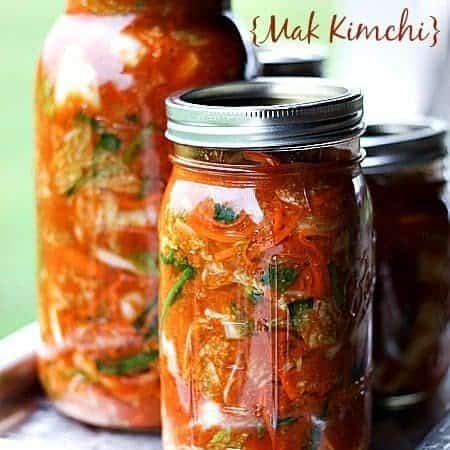
Easy, Fast Kimchi Recipe {Mak Kimchi}
Rate RecipeIngredients
- 3-8 pounds napa cabbage
- 2 bunches green onions trimmed of the root bits
- 2-3 large carrots peeled, thinly julienned
- 1/2 cup kosher salt
- 1/2 cup korean chili powder
- 15-20 cloves garlic overdoing garlic makes this stay on your breath more than usual., peeled
- 4-6 inches ginger peeled, rough chopped
- 1 tablespoon fish sauce
- unsweetened pear juice or unsweetened apple juice
- 4 tablespoons white miso paste
Instructions
- Cut the napa cabbage in half longways, then in half again longways. Cut the core out of the four quarters. Cut the cabbage into squares (about 2-3 inches square), pop it in a bowl with the carrots. Sprinkle with the 1/2 cup kosher salt, massage so everything is coated in salt and starting to soften and wilt. Fill with cold, chlorine free water to cover it well and let it soak for at least 1 1/2 hours.
- Pour the cabbage and carrots and liquid into a strainer. Let the brine drain away.
- Lob off the white bits of the green onions and put them in a food processor with the garlic cloves, ginger, miso paste, and korean pepper powder. Zap it on high ’til it’s smooth-ish. Add in the fish sauce and a couple of slops of pear juice and zap it more until it’s about pancake batter consistency… maybe a bit thinner.
- Put the brined cabbabe/carrots in a big, anti-reactive (glass, enamel, or stainless steel) bowl. Rough chop the green parts of the onions and add those to the cabbage/carrots. Pour the chili paste combo over the cabbage and wear gloves to massage it all over the cabbage/carrots green onions so everything is completely covered.
- Pack super tight in canning jars. CRAM it in there. Add a two-piece lid, but just set the ring in place to hold the lid down without screwing it in place. Place it on a rimmed baking dish to catch any spill-over. Let it sit at room temperature for up to 72 hours, until it is bubbly and fragrant. Once every day, insert a clean chopstick or butterknife to release air bubbles. If needed, pour in some additional brine to keep all the vegetables submerged.
- Store on a rimmed sheet in the refrigerator for up to six months, being sure that the vegetables are submerged the whole time. The older it gets, the stronger it will become.
Notes
Nutrition
Nutritional information is an estimate and provided to you as a courtesy. You should calculate the nutritional information with the actual ingredients used in your recipe using your preferred nutrition calculator.
did you make this recipe?
Make sure to tag @foodiewithfam on Instagram and #hashtag it #foodiewithfamily so I can check it out!
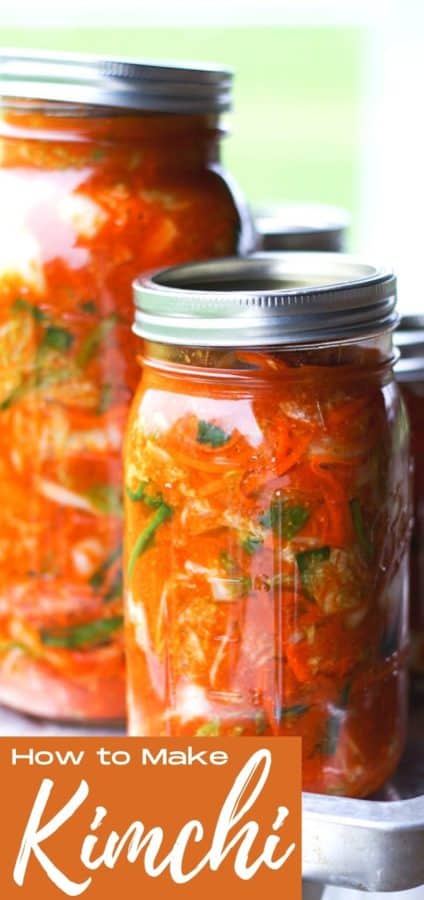
This post was originally published on December 2, 2013 and was updated December 28, 2016, June 2018, and September 2021.
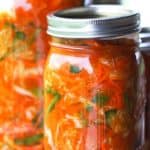



Reader's Thoughts...
Bev says
Hi , can you use a substitute for napa cabbage as I can’t get it where I live? Thanks
Tanja De Beer says
Hi…ive scrolled up and down and cant find your paste ingredient list… It says and ‘whatnot’…
Rebecca says
Hi Tanja- Scroll down to the printable recipe card, and the ingredients are listed there. If you click “print recipe” everything you need is right there.
Zehanne says
Hi, i dont have the korean chili powder but i do have the gojuchang (korean chili paste) would that do? Tnx…
Rebecca says
I have been told it can be used, but you’ll definitely want to adjust any other salty elements you use because gochujang is already salty. 🙂 Best of luck!
Randy says
Your web page is so chock full of ads and the page is continually jumping around while all the ads are loading and then video … I’ve overwhelmed. I never got to see the full recipe for all the trash that kept loading. I’ve told my browser if your webpage is requested to warn me first. Your recipe looked nice, too! Sorry! Gotta go elsewhere without all the ads.
Rebecca says
Hi Randy- I’m sorry you experienced crazy ad loading. The company I use for my ads is very good about listening to complaints when ads are reported. There should be an option to report ads that are intrusive right beneath each ad. Please do avail yourself of that. As for why the ads are there, in short, it’s because I spend quite a lot of time and money to run the website which I make available for free (for the low price of scrolling past ads), and the ad revenue not only helps offset it, but is also my paycheck.
Randy says
It wasn’t my intent to be offensive and clearly I’ve hit a nerve. I get this may be your “living” but that a rough way to make a dime by exposing people to that intense barrage of ads. No doubt you must be making a fortune. I really just thought you’d like to know those ads are a little heavy, but maybe not. It shouldn’t be my place to partner with your ad team to tell them when too much is too much! I’ve loaded foodiewithfamily in my browser to stop me and warn me if I accidentally click on it again. Again, my apologies if you found my comments offensive. I mistaken thought you’d want to know when you were losing viewers to excessive ads.
Rebecca says
Nope! No nerve was hit. I was just explaining myself. I understand that you’ve placed my site on a warning list in your browser. I honestly understood it before, too. I’m not offended at all, but I do believe it’s my duty to explain myself, so I did. I’m sorry that you’re offended by it. Most publications -digital or print- carry quite a few ads, and some more than others. I’ve got 5 boys to send to college, so this is where we’ll be a while. I’m sorry you won’t get the chance to try my excellent recipes. I hope some day you’ll try again, but if not, please be well!
J says
What a wanker
Debbi says
SOOOOOO good! My first time making kimchi & I am in love. Yum. Thanks so much for sharing this recipe.
Rebecca says
Hooray, Debbi! Thanks for letting me know you love it and for the great rating!
Jessi says
Hello. Can you please clarify in step 5: “If needed, pour in some additional brine to keep all the vegetables submerged.” Which brine you speak of? The salt water brine was disposed of in step 2: “Let the brine drain away.” If it is necessary to make new brine what are the ingredients and ratios. Thank you!
Rebecca says
Hi Jessi- Yes. This is a common question. Maybe I should update the recipe to give brine information. 🙂 Add 4 tablespoons to a quart of water and stir until the salt is dissolved. Use this to top off your veggies if they’re not submerged. 🙂
Ryan says
This is a great starting point to making real kimchi. I first made a small batch and didn’t have have pear or apple juice but had white grape juice. I used some celery in place of carrots and regular cabbage. I prepped it then packed it. I needed a little more abuse to cover the top that I didn’t have I put a few spoons of water in shook the mixture and replaced. I placed it on the counter . The next day she was working. I brew beer so watching it ferment was nice. It turned out great! I ate it in a week my wife even ate some and wanted more. I started a new batch today and using the carrots and a fresh apple and squeezed orange in the paste.
Katie S. says
I just used this recipe as a basis to make my first batch ever of made from scratch kimchee. So to start-thank you! Thanks for sharing a somewhat simple way for beginners like me. My husband is a diehard kimchee fan and I wanted to learn how to make it at home for him so I could spoil him as much as he spoils me.
I didn’t have the Korean red pepper powder this time (but I fully intend on buying some on Amazon or at a local market in the very near future) so I winged it to try to make a decent substitute. I had red pepper flakes on hand, chili powder, cayenne pepper and smoked paprika which I slowly added Sambal to, to make a paste. That’s what I added to the food processor in your step with the green onions, garlic cloves and ginger. I also added a touch of rice wine vinegar to it at the end to get a flavor my husband and I both liked.
My kimchee is currently jarred and done, waiting for the beautiful fermentation process to begin and I will update you when it’s finished to let you know if my adjustments screwed it all up or not, lol!
Thanks for the amazing recipe with step by step instructions!
cathy says
I made my first batch Sunday and can’t wait to try it. I was a little afraid to leave it our at room temp so I put it in the fridge but after 2 days it still wasn’t fermenting so It is now out at room temp. I am now questioning Katies addition of rice wine vinegar. I read somewhere that anything with vinegar takes away the health benefits of eating fermented food. Does anybody know anything about this?
Tom says
Just a small point – the best kimchi is made using your bare hands, not using gloves. There is actually some science behind this. Take a look at the book “Never Home Alone” by Rob Dunn. He has an entire section on the microflora of kimchi and the importance the cook’s contribution to the final product. Kimchi mixed with (clean) bare hands is actually a healthier food!
Lukas TS says
Great recipe, easy to follow & allows for personal creativity! I probably had too much salt at first , so after adding more veggies (sliced radishes & chopped cabbage) enjoyed the reduced saltiness and varying degrees of crunchiness!
Have polished off half of the three quart batch in two weeks!
Thanks for adding to my repertoire!
Lukas
Gena London says
You meantion we should not increase certain ingredients because will effect the taste, but no where in this recipe does it tell me how much of each ingredient to use other than the Napa cabbage. Can I get the complete recipe?
Paula says
What else besides carrots. Can I add? Zucchini or yellow squash ok? Celery?
Gaama says
I don’t get it. 3lbs and 8lbs is a huge difference. I wanna know the exact amount of spices and other ingredients for a certain amount of cabbage. Can you tell me how many pounds of napa cabbage should I use for this recipe?
Rebecca says
Hi Gaama- You can do the same amount of paste for a range of cabbage from 3 to 8 pounds. If you do the smaller amount of cabbage, it’ll be stronger and spicier. The lesser amount of cabbage will be flavourful and delicious, but slightly less spicy. As you can see from the many comments by people who have made this, it works out. This doesn’t have to be surgically precise; that’s the beauty of fermentation.
Lachlan says
Great Recipe, First time I tried it was a hit with my family and all my colleagues, now I need to make more for everyone. Hopefully the second batch turns out as good as the first. The Kimchi improves with age IMO, well it was the best its been when we finished the last of it today, around 3 months since prepared.
Rebecca says
Hey Lachlan- Thanks so much for letting me know you love it and it worked out well for you. I love the older kimchi, too, personally. I like how funky and bubbly it gets.
Suzanne says
After it ferments the 72 hours at room temp and we can put into refridgerator, can we tighten the lids to store for a few weeks or does lid have to remain loose? Also after it has been refridgerated do you still have to release air bubbles each day?
Rebecca says
Hey Suzanne- I don’t advise having it shut tight at any point if you have it in glass. I keep my kimchi jars on a little rimmed mini pan (like a 1/4 sheet pan) or a slightly raised edge plate to keep any bubbling over juices from pooling on the refrigerator shelf.
Shaadi says
Do you have to add the spicey bits? I dont like spice.
Rebecca says
Hi Shaadi- I’m afraid I don’t have a recipe for making this without the hot pepper.
John says
I’m not sure what proportions of salt to water to use for the brine. This is my first try. thanks, jb
Rebecca says
Hi John- Generally, the brine should be 4 tablespoons of salt to a quart of water, stirred until the salt dissolves. 🙂
sue says
amazing recipe…
easy and so very tasty…
i normally try out a few recipes, when ever i try new things, but i think this is the one and only recipe I’ll need
i’ve stored mine in plastic tubs and need to release gases every other day, as the tubs will bulge dramatically
thank you for sharing
Rebecca says
Thanks so much, Sue! I’m so glad you love it. 🙂
Chad says
Maybe I’m blind but I don’t see how much apple juice is used in the recipe?
Rebecca says
Hey Chad- There isn’t a hard and fast quantity, you’re not blind. You’re basically looking to add enough to loosen your paste up enough to spread easily on the Napa cabbage without it running off.
Cara says
Super easy to make. Can’t wait for it to ferment!!!